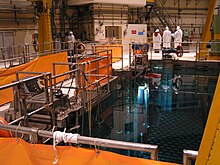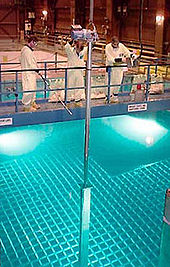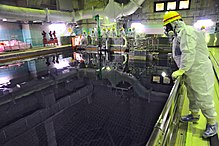
Spent fuel pools (SFP) are storage pools (or "ponds" in the United Kingdom) for spent fuel from nuclear reactors. They are typically 40 or more feet (12 m) deep, with the bottom 14 feet (4.3 m) equipped with storage racks designed to hold fuel assemblies removed from reactors. A reactor's local pool is specially designed for the reactor in which the fuel was used and is situated at the reactor site. Such pools are used for short-term cooling of the fuel rods. This allows short-lived isotopes to decay and thus reduces the ionizing radiation and decay heat emanating from the rods. The water cools the fuel and provides radiological protection from its radiation.
Pools also exist on sites remote from reactors, for longer-term storage such as the Independent Spent Fuel Storage Installation (ISFSI), located at the Morris Operation, or as a production buffer for 10 to 20 years before being sent for reprocessing or dry cask storage.
While only about 20 feet (about 6 m) of water is needed to keep radiation levels below acceptable levels, the extra depth provides a safety margin and allows fuel assemblies to be manipulated without special shielding to protect the operators.
Operation

About a quarter to a third of the total fuel load of a reactor is removed from the core every 12 to 24 months and replaced with fresh fuel. Spent fuel rods generate intense heat and dangerous radiation that must be contained. Fuel is moved from the reactor and manipulated in the pool generally by automated handling systems, although some manual systems are still in use. The fuel bundles fresh from the core are normally segregated for several months for initial cooling before being sorted into other parts of the pool to wait for final disposal. Metal racks keep the fuel in controlled positions for physical protection and for ease of tracking and rearrangement. High-density racks also incorporate boron-10, often as boron carbide (Metamic, Boraflex, Boral, Tetrabor and Carborundum) or other neutron-absorbing material to ensure subcriticality. Water quality is tightly controlled to prevent the fuel or its cladding from degrading. This can include monitoring the water for contamination by actinides, which could indicate a leaking fuel rod. Current regulations in the United States permit re-arranging of the spent rods so that maximum efficiency of storage can be achieved.

The maximum temperature of the spent fuel bundles decreases significantly between two and four years, and less from four to six years. The fuel pool water is continuously cooled to remove the heat produced by the spent fuel assemblies. Pumps circulate water from the spent fuel pool to heat exchangers, then back to the spent fuel pool. The water temperature in normal operating conditions is held below 50 °C (120 °F). Radiolysis, the dissociation of molecules by radiation, is of particular concern in wet storage, as water may be split by residual radiation and hydrogen gas may accumulate increasing the risk of explosions. For this reason the air in the room of the pools, as well as the water, must be continually monitored and treated.
Other possible configurations
Rather than manage the pool's inventory to minimize the possibility of continued fission activity, China is building a 200 MWt nuclear reactor to run on used fuel from nuclear power stations to generate process heat for district heating and desalination. Essentially an SFP operated as a deep swimming pool reactor; it will operate at atmospheric pressure, which will reduce the engineering requirements for safety.
Other research envisions a similar low-power reactor using spent fuel where instead of limiting the production of hydrogen by radiolysis, it is encouraged by the addition of catalysts and ion scavengers to the cooling water. This hydrogen would then be removed to use as fuel.
Risks

The neutron absorbing materials in spent fuel pools have been observed to degrade severely over time, reducing the safety margins of maintaining subcriticality; in addition, it has been shown that the in-site measurement technique used to evaluate these neutron absorbers (Boron Areal Density Gauge for Evaluating Racks, or BADGER) has an unknown degree of uncertainty.
If there is a prolonged interruption of cooling due to emergency situations, the water in the spent fuel pools may boil off, possibly resulting in radioactive elements being released into the atmosphere.
In the magnitude 9 earthquake that struck the Fukushima nuclear plants in March 2011, three of the spent fuel pools were in buildings which had been damaged and were seen to be emitting water vapour. The US NRC wrongly stated that the pool at reactor 4 had boiled dry—this was denied at the time by the Government of Japan and found to be incorrect in subsequent inspection and data examination.
According to nuclear plant safety specialists, the chances of criticality in a spent fuel pool are very small, usually avoided by the dispersal of the fuel assemblies, inclusion of a neutron absorber in the storage racks and overall by the fact that the spent fuel has too low an enrichment level to self-sustain a fission reaction. They also state that if the water covering the spent fuel evaporates, there is no element to enable a chain reaction by moderating neutrons.
According to Dr. Kevin Crowley of the Nuclear and Radiation Studies Board, "successful terrorist attacks on spent fuel pools, though difficult, are possible. If an attack leads to a propagating zirconium cladding fire, it could result in the release of large amounts of radioactive material." After the September 11, 2001 attacks the Nuclear Regulatory Commission required American nuclear plants "to protect with high assurance" against specific threats involving certain numbers and capabilities of assailants. Plants were also required to "enhance the number of security officers" and to improve "access controls to the facilities".
On August 31, 2010, a diver servicing the spent fuel pool at the Leibstadt Nuclear Power Plant (KKL) was exposed to radiation in excess of statutory annual dose limits after handling an unidentified object, which was later identified as protective tubing from a radiation monitor in the reactor core, made highly radioactive by neutron flux. The diver received a hand dose of about 1,000 mSv which is twice the statutory limit of 500 mSv. According to KKL authorities the diver has not suffered any longtime consequences from the accident.
See also
- Deep geological repository
- Dry cask storage
- Lists of nuclear disasters and radioactive incidents
- Nuclear fuel cycle
- Radioactive waste
- Spent nuclear fuel shipping cask
- Cherenkov radiation
References
- "Neutron Absorber Material Archived 2019-03-21 at the Wayback Machine", Holtec International
- ^ Spent Fuel Storage; Neutron Absorbing Materials, "Nuclear Engineering Handbook", edited by Kenneth D. Kok, p. 302
- "3M™ Neutron Absorber Composite (formerly known as Boral® Composite) Archived 2018-02-14 at the Wayback Machine"
- ^ "Monitoring Degradation of Phenolic Resin-Based Neutron Absorbers in Spent Nuclear Fuel Pools Archived 2017-05-07 at the Wayback Machine", Matthew A. Hiser, April L. Pulvirenti and Mohamad Al-Sheikhly, U.S. Nuclear Regulatory Commission Office of Nuclear Regulatory Research, June 2013
- ^ "NRC: Spent Fuel Pools". Archived from the original on 12 March 2016. Retrieved 18 March 2016.
- ^ "Initial Assessment of Uncertainties Associated with BADGER Methodology Archived 2019-06-22 at the Wayback Machine", J. A. Chapman and J. M. Scaglione, Oak Ridge National Laboratory, September, 2012
- Chaplin J, Christl M, Straub M, Bochud F, Froidevaux P (2 June 2022). "Passive Sampling Tool for Actinides in Spent Nuclear Fuel Pools". ACS Omega. 7 (23): 20053−20058. doi:10.1021/acsomega.2c01884. hdl:20.500.11850/554631. PMID 35722008.
- "Members - USA - Utilities Services Alliance". Archived from the original on 4 March 2016. Retrieved 18 March 2016.
- "UIC - Newsletter 5/02". Archived from the original on 13 October 2007. Retrieved 18 March 2016.
- "Radiolytic Water Splitting: Demonstration at the Pm3-a Reactor". Archived from the original on 4 February 2012. Retrieved 18 March 2016.
- "Resolution of Generic Safety Issues: Issue 196: Boral Degradation (NUREG-0933, Main Report with Supplements 1–34)", U.S. Nuclear Regulatory Commission
- "Nuclear Crisis in Japan FAQs". Union of Concerned Scientists. Archived from the original on 2011-04-20. Retrieved 2011-04-19.
- "No water in spent fuel pool at Japanese plant: U.S". CTV News. 16 March 2011.
- "U.S.: spent fuel pool never went dry in Japan quake". Associated Press. 15 June 2011. Archived from the original on 29 October 2013. Retrieved 24 October 2013.
- Criticality Safety in the Waste Management of Spent Fuel from NPPs, Robert Kilger Archived 2011-05-11 at the Wayback Machine
- "Nondestructive assay of nuclear low-enriched uranium spent fuels for burnup credit application". Archived from the original on 3 May 2011. Retrieved 18 March 2016.
- Radioactive Waste Management/Spent Nuclear Fuel
- ^ "Are Nuclear Spent Fuel Pools Secure?" Council on Foreign Relations, June 7, 2003 "Are Nuclear Spent Fuel Pools Secure? - Council on Foreign Relations". Archived from the original on 2011-04-12. Retrieved 2011-04-05.
- "Exposure of a worker in excess of statutory annual dose limits". www-news.iaea.org. Retrieved 2021-06-09.
- Ritter, Andreas. "Unplanned Exposure During Diving in the Spent Fuel Pool". isoe-network.net.
External links
- Radiological Terrorism: Sabotage of Spent Fuel Pool
- Storage of Spent Nuclear Fuel U.S. Nuclear Regulatory Commission (NRC)
- An example diagram of a Spent Fuel Pool Indian Point Energy Center
- "Geek Answers: Does nuclear waste really glow?" BY GRAHAM TEMPLETON 07.17.2014 at Geek.com
